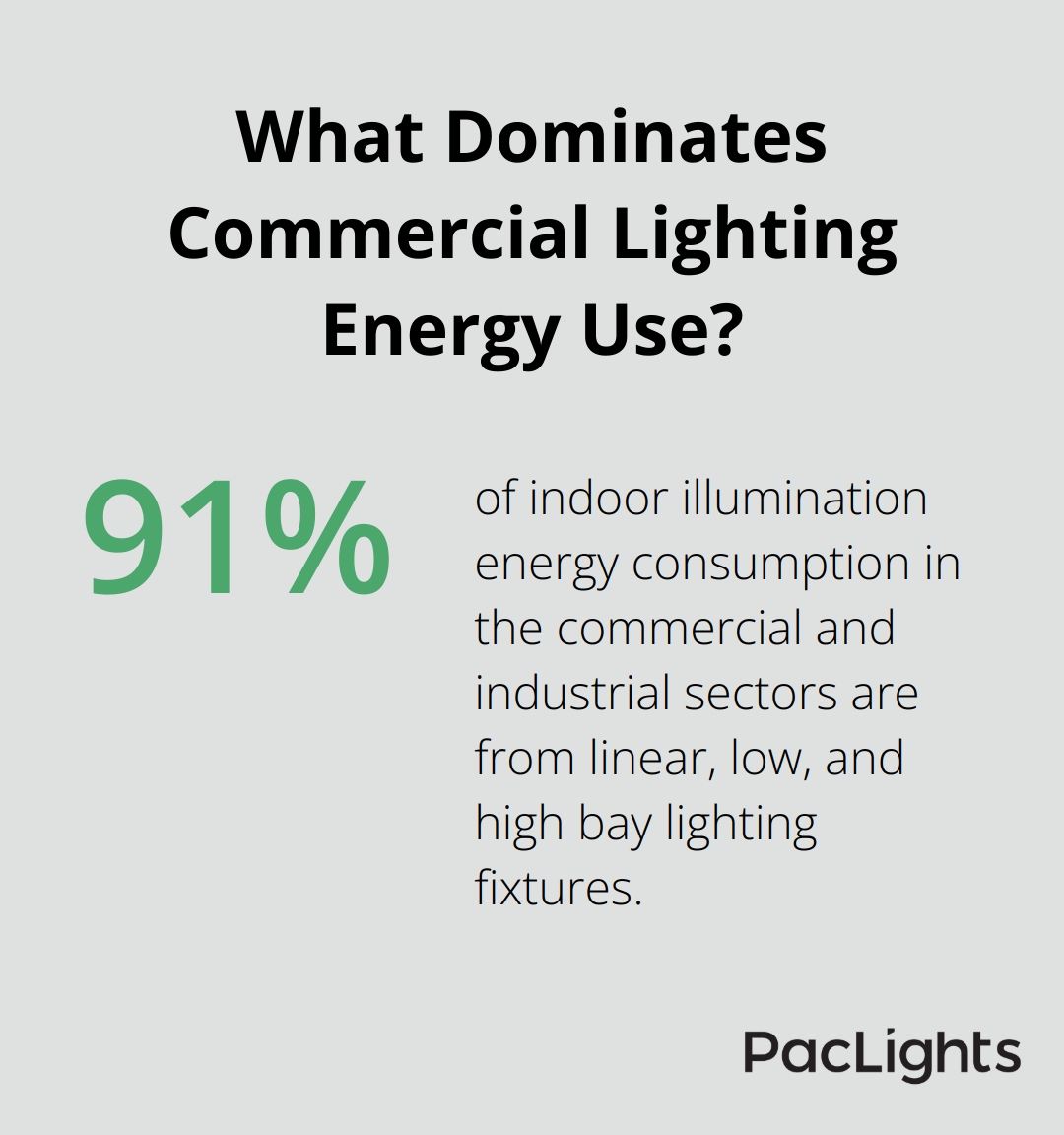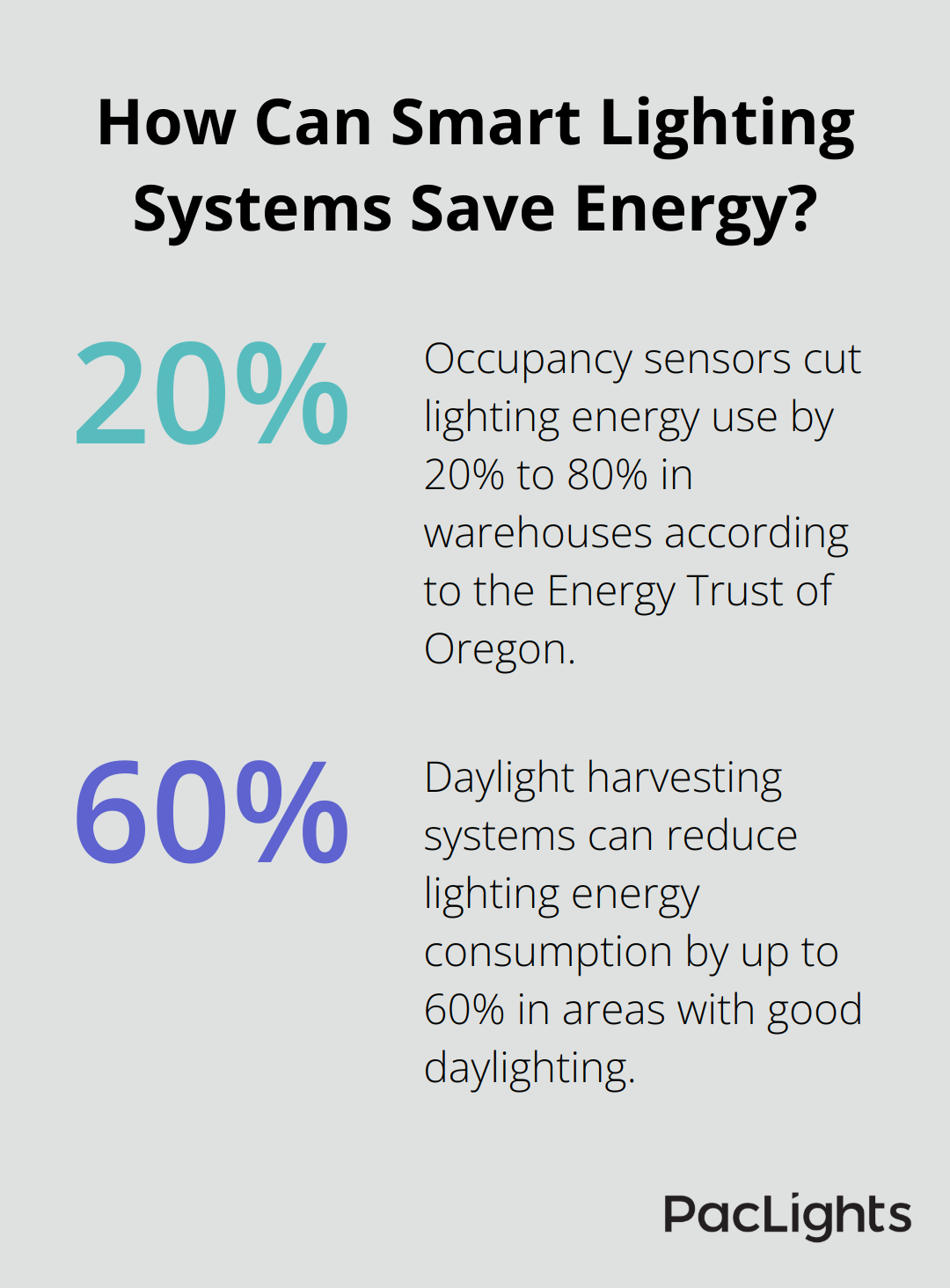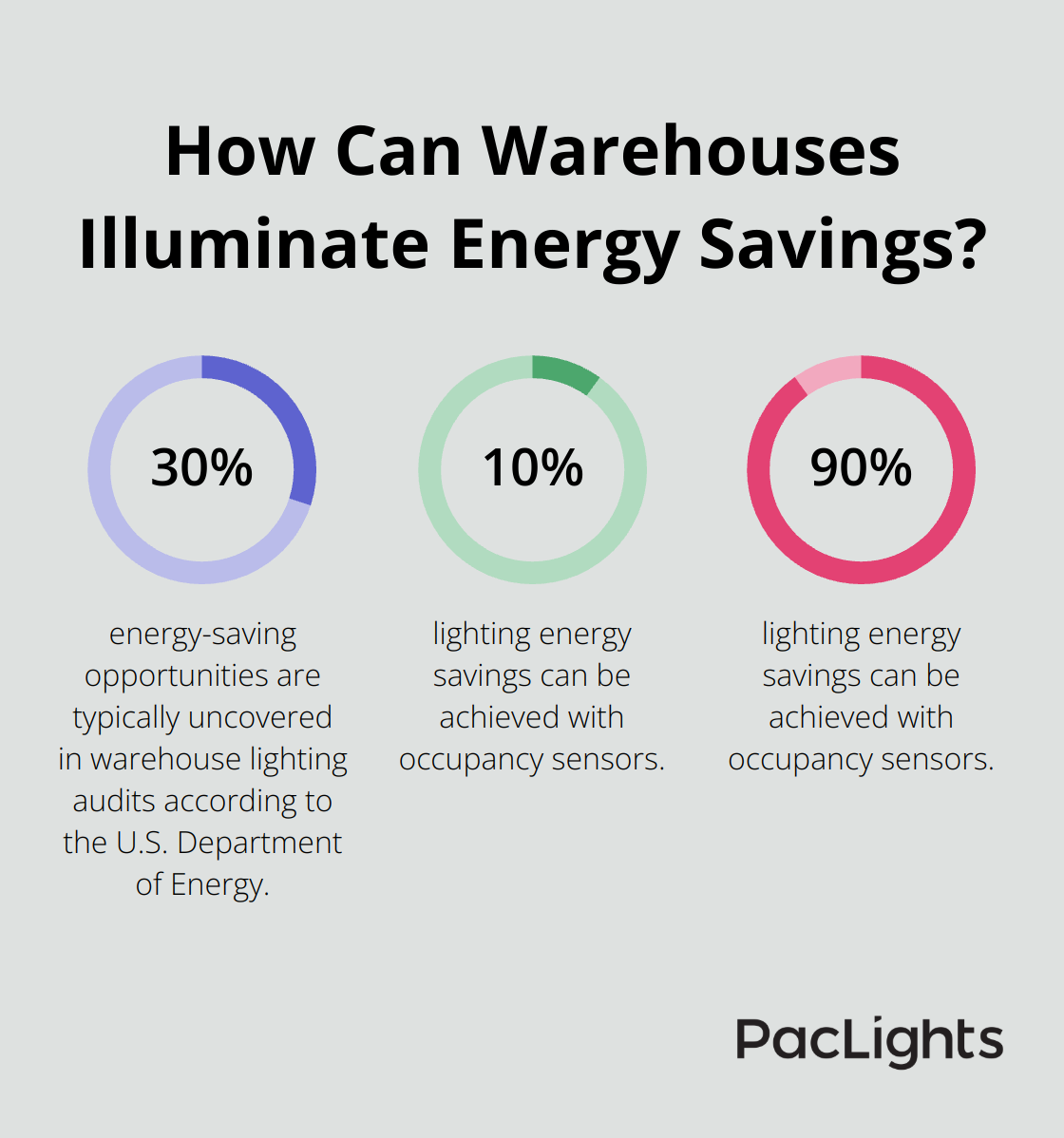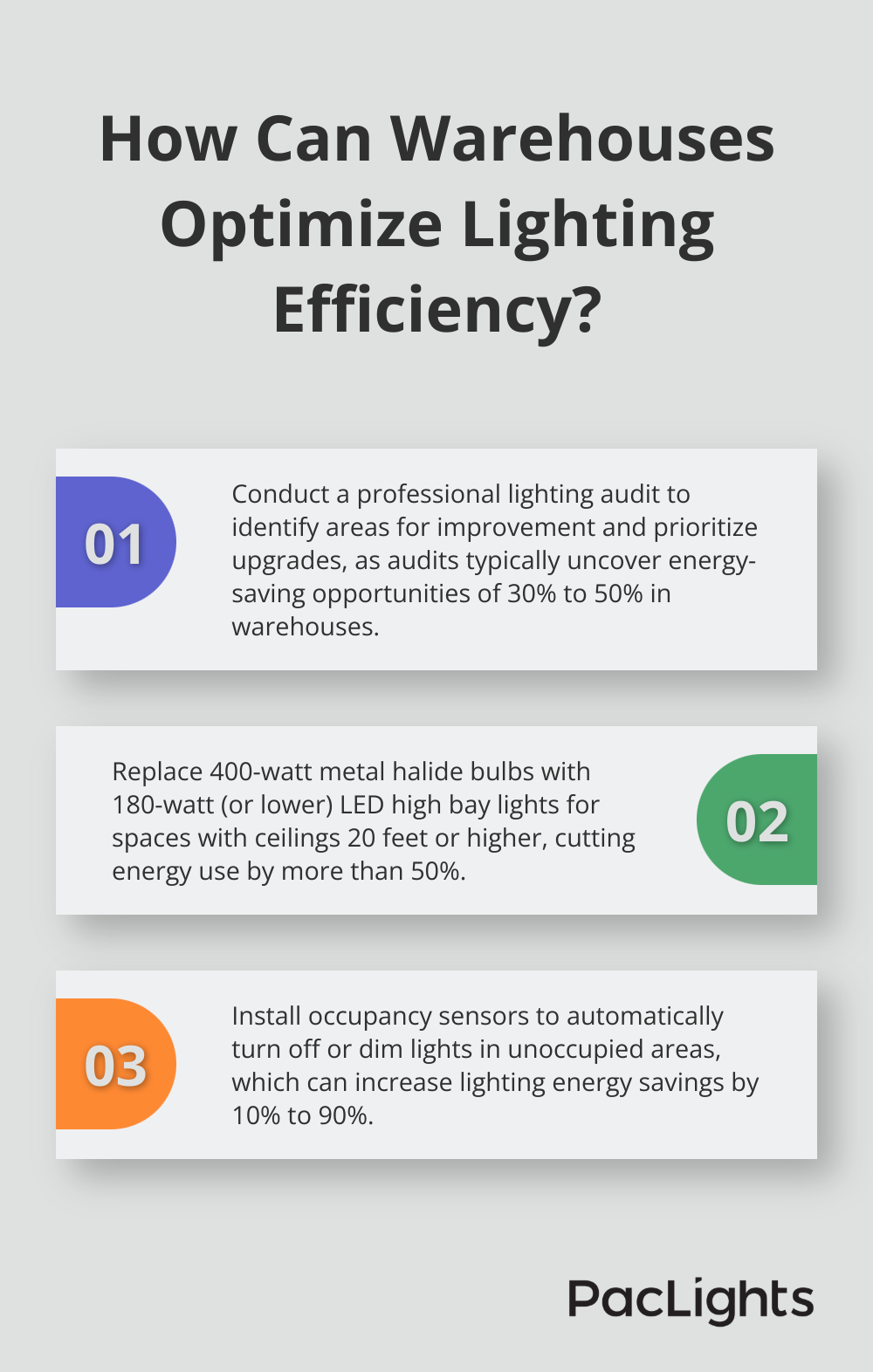Warehouses are energy-hungry spaces, often guzzling electricity through outdated lighting systems. At PacLights, we’ve seen firsthand how high efficiency warehouse lighting can dramatically slash energy consumption and operational costs.
Modern lighting solutions not only save money but also enhance visibility, safety, and worker productivity. In this post, we’ll explore the advantages of efficient lighting and provide practical steps for implementation in your warehouse.
Why High Efficiency Lighting Transforms Warehouses
Dramatic Energy Savings
High efficiency warehouse lighting revolutionizes energy consumption for businesses. Up to 91% of indoor illumination energy consumption in the commercial and industrial sectors are from linear, low, and high bay lighting fixtures. This substantial decrease directly impacts utility bills and shrinks a facility’s carbon footprint. The U.S. Department of Energy projects that widespread LED adoption could save over $30 billion in electricity costs nationwide by 2027, highlighting the massive potential for savings.
Operational Cost Reduction
The financial benefits of high efficiency lighting extend far beyond energy savings. LED fixtures typically last between 50,000 to 100,000 hours (compared to 10,000 to 20,000 hours for traditional lighting). This longevity translates to fewer replacements and reduced maintenance, which significantly cuts operational costs over time. Warehouse managers who switch to LEDs often report substantial decreases in their annual lighting-related expenses.
Enhanced Workplace Safety
High efficiency lighting creates a safer work environment. LED lights provide clearer, more uniform illumination, which eliminates shadows and dark spots that often lead to accidents. The Occupational Safety and Health Administration (OSHA) identifies poor lighting as a contributing factor in many workplace incidents. Upgrading to high efficiency lighting can markedly improve visibility and potentially lower accident rates in warehouses.
Productivity Boost
Improved lighting quality doesn’t just enhance safety-it also boosts productivity. Workers in well-lit environments report less eye strain and fatigue, leading to increased focus and efficiency. Some studies suggest that optimized lighting can increase productivity by up to 10% (though results may vary depending on the specific workplace and tasks involved).
Future-Proofing Your Facility
Investing in high efficiency lighting positions warehouses for future success. As energy regulations tighten and sustainability becomes increasingly critical, facilities with outdated lighting systems may face penalties or higher operational costs. Making the switch now not only saves money immediately but also prepares your warehouse to meet future energy standards effortlessly.

The next step in optimizing warehouse lighting involves understanding the various types of high efficiency fixtures available and how to implement them effectively in your specific space. Let’s explore these options and strategies to maximize the benefits of your lighting upgrade.
Choosing the Right High Efficiency Lighting
Warehouse lighting requires a tailored approach to maximize energy savings and operational efficiency. The most effective options for modern warehouses include:
LED High Bay Lights: The Warehouse Workhorse
LED high bay lights illuminate large, open spaces from heights of 20 feet or more. These powerful fixtures offer several advantages over traditional metal halide or fluorescent options:
- Energy Efficiency: LED high bays can replace a 400-watt metal halide bulb with a 180-watt (or less) LED, resulting in significant energy savings.
- Longevity: With lifespans of 50,000 to 100,000 hours, LED high bays cut maintenance costs significantly.
- Instant On: LEDs reach full brightness immediately, which enhances safety during power interruptions.
- Better Light Quality: LEDs provide more uniform illumination, which reduces shadows and improves visibility throughout the warehouse.
Smart Lighting Systems: Automation for Optimal Efficiency
The integration of smart controls with LED fixtures elevates warehouse lighting efficiency. Occupancy sensors and daylight harvesting systems reduce energy waste dramatically:
- Occupancy Sensors: These devices turn off lights in unoccupied areas automatically. The Energy Trust of Oregon reports that occupancy sensors cut lighting energy use by 20% to 80% in warehouses.
- Daylight Harvesting: These systems adjust artificial light levels based on available natural light, which reduces lighting energy consumption by up to 60% in areas with good daylighting.
- Networked Lighting Controls: Advanced systems allow for precise control and monitoring of lighting throughout the facility, which optimizes energy use and provides valuable data for further improvements.
Task-Specific Lighting: Precision Illumination
Different areas in a warehouse require varying levels of lighting. Task-specific lighting solutions ensure that each zone has the appropriate illumination for its function:
- Aisle Lighting: Linear LED fixtures with narrow beam angles provide focused light for shelving areas, which improves visibility for order picking and reduces overall energy use.
- Loading Dock Lighting: High-output, weather-resistant fixtures ensure safety and efficiency in these high-traffic areas.
- Office and Break Room Lighting: LED panel lights or troffers offer comfortable, glare-free illumination for administrative spaces.

The implementation of these high-efficiency lighting solutions can transform a warehouse’s energy profile. For example, a 100,000 square foot warehouse that switches from metal halide to LED high bay lighting with smart controls could see annual energy savings of over $50,000 (based on average U.S. electricity rates).
The initial investment in high-efficiency lighting may seem substantial, but the long-term benefits far outweigh the costs. Many facilities see a return on investment within 2-3 years, with energy savings that continue to accumulate for years to come.
The selection of the right lighting solution requires careful consideration of your specific warehouse needs. The next step involves the implementation of these high-efficiency lighting systems in your facility, which we will explore in the following section.
How to Implement High Efficiency Lighting
Conduct a Comprehensive Lighting Audit
Start with a thorough assessment of your current lighting system. A professional lighting audit reveals important insights about your energy consumption, light quality, and potential areas for improvement. During the audit, experts measure light levels throughout your warehouse, identify inefficient fixtures, and analyze your energy bills.

The U.S. Department of Energy reports that lighting audits typically uncover energy-saving opportunities of 30% to 50% in warehouses. These audits also help prioritize areas for upgrades, ensuring you get the most value for your investment.
Select the Right Fixtures for Your Space
After you obtain audit results, choose the appropriate high efficiency fixtures. Consider factors like ceiling height, task requirements, and ambient conditions. For areas with high ceilings (20 feet or more), LED high bay lights often prove the best choice. These fixtures can replace 400-watt metal halide bulbs with 180-watt (or lower) LED alternatives, cutting energy use by more than 50%.
For aisles and shelving areas, linear LED fixtures with narrow beam angles provide focused illumination where it’s needed most. This targeted approach improves visibility for order picking and reduces overall energy consumption.
Optimize Fixture Placement and Installation
Proper placement of your new high efficiency fixtures maximizes their benefits. Use lighting design software to create a layout that ensures uniform illumination throughout your warehouse. This step eliminates dark spots and reduces the total number of fixtures needed, further cutting energy costs.
During installation, pay close attention to mounting heights and angles. Incorrect positioning can lead to glare or shadows, negating the benefits of your lighting upgrade. Many warehouses see significant improvements in worker comfort and productivity simply by optimizing fixture placement.
Integrate Smart Controls for Maximum Efficiency
To extract every last bit of efficiency from your new lighting system, integrate smart controls. Occupancy sensors increase lighting energy savings by turning off or turning down the lights when rooms are unoccupied. Lighting energy savings of 10% to 90% can be achieved with these sensors.
Networked lighting controls take efficiency even further. These systems allow for granular control over your entire lighting setup, enabling features like task tuning (adjusting light levels for specific tasks) and demand response (automatically reducing lighting loads during peak energy periods).
When you implement these advanced controls, properly commission the system and train your staff on its use. A well-tuned smart lighting system can lead to significant energy savings compared to traditional lighting setups.
High efficiency warehouse lighting transforms businesses by reducing energy consumption and operational costs. Warehouses can expect to cut lighting-related electricity usage by more than half, resulting in significant utility bill savings and a smaller carbon footprint. The long-term advantages extend beyond energy savings, as these durable fixtures require less frequent replacement and maintenance.

Improved lighting quality enhances workplace safety and worker comfort. The elimination of shadows and dark spots potentially reduces accidents, while better visibility decreases eye strain and fatigue. These improvements can positively impact employee morale, productivity, and retention (factors that contribute to overall business success).
We at PacLights offer a range of high efficiency lighting solutions designed for warehouse environments. Our team can guide you through selecting and implementing the right lighting system for your facility. Switching to high efficiency warehouse lighting represents an investment in a brighter, more sustainable future for your business.






Disclaimer: PacLights is not responsible for any actions taken based on the suggestions and information provided in this article, and readers should consult local building and electrical codes for proper guidance.